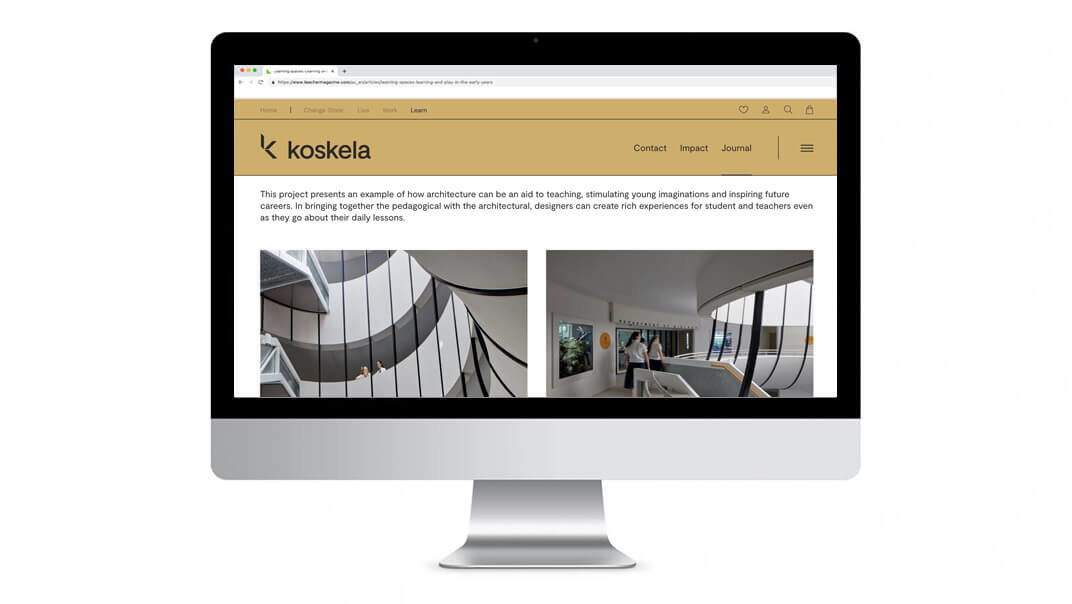
Science Learning Centre featured by Koskela
Architecture as ‘teacher’ in school design
Schools are environments designed for learning, but what if the building itself could teach? This article explores how architecture can help students understand complex ideas and be inspired to pursue a career in science.
School architecture has to fulfill a number of different criteria, from programs stipulating numbers of classrooms, wet areas and outdoor spaces, to spatial requirements for specialist activities, to acoustic considerations and other a whole host of other requirements for pedagogical best practice. But what if architecture can do even more than this? What if it can be a teacher in its own right?
Mary Featherston, known for her work with husband Grant Featherston on some of Australia’s most iconic furniture designs from 1965 to 1995, dedicated her career to the design of play and learning environments after Grant’s death in 1995. The Featherston Archive includes a number of her writings, designs and exhibitions on the theory and practice of designing children’s centres, primary and secondary schools. Inspired by the Italian approach to learning, Reggio Emilia, her work with educators, architects and policy-makers over the past decades has focused on progressive schooling – a project-based approach that prioritises young people’s curiosity and drive to learn.
For Featherston, schools must be purposefully designed and must be non-hierarchical, creating space for democratic relationships.
Flexible furniture has the functionality to create boundaries for group settings – from minimal floor changes to transparent partitions to solid walls – while also maintaining a sense of stability so everyone knows where everything is, and time and energy is not wasted on scene changes. For Featherston, the physical environment must be intentionally designed as a setting for learning. She says: “when the physical environment is purposely designed to support particular values and beliefs, it becomes a teacher in itself.”
The Science Learning Centre at Brisbane Girls Grammar School does just that. The architecture, by Brisbane studio M3, teaches a range of complex scientific ideas, from the shape of black hole, to the phases of a star, to the three ways of calculating north. This seven-storey building situated on the school’s Spring Hill campus is the third to be designed by M3 architecture whose first job was to map out a space on the already-crowded site. The upper four floors are dedicated to teaching science, with one floor dedicated each to general science, biology, physics and chemistry – with the geometries of the building demonstrating some key ‘teachable moments’ in science.
In the centre of the building is a full-height atrium open to the sky whose shape is based on the curvature of space time, which is also the shape of a black hole. These lines continue to wrap the outside of the building, creating an optical illusion so the building looks curved – in fact it is a rectilinear box. “We wanted to use the architecture itself as a series of teachable moments in science,” says Michael Banney from m3. “A single student might spend 2000 days learning science in this building and that’s enough time to get you used to a complex idea. It takes time to realise that you might want a future in science.”
The colour-coding on each floor is also science themed, with each colour representing the different stages of a star – the stellar cloud on the ground floor is represented by black bromeliad plants in the gardens, the large star is yellow, the red supergiant is red and the supernova is blue. The stairs, too, have an educational element – each of the three sets of stairs stacked on top of each other connecting the floors could have simply lined up, but instead they are all at slightly different angles, pointing towards a different north – True North, Grid North and Magnetic North. “Rather than tucking all that stuff away, the girls get to experience all of it,” says Michael. “What it’s about really about is stimulating students in their quest for knowledge.”
This project presents an example of how architecture can be an aid to teaching, stimulating young imaginations and inspiring future careers. In bringing together the pedagogical with the architectural, designers can create rich experiences for student and teachers even as they go about their daily lessons.
References
Featherston, Mary, “Transforming Education: Purposeful Design for Learning – The New Pedagogy” in EXCHANGE: Collaboration,Convergence, Conversations. https://www.featherston.com.au/transforming-education-2013
See the original article here.
Visit the project page Brisbane Girls Grammar School Science Learning Centre for more information.